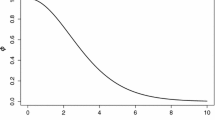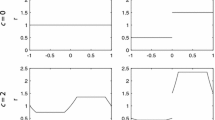Summary
A mathematical model for the dispersal of an animal population is presented for a system in which animals are initially released in the central region of a uniform field and migrate randomly, exerting mutually repulsive influences (population pressure) until they eventually become sedentary. The effect of the population pressure, which acts to enhance the dispersal of animals as their density becomes high, is modeled in terms of a nonlinear-diffusion equation. From this model, the density distribution of animals is obtained as a function of time and the initial number of released animals. The analysis of this function shows that the population ultimately reaches a nonzero stationary distribution which is confined to a finite region if both the sedentary effect and the population pressure are present. Our results are in good agreement with the experimental data on ant lions reported by Morisita, and we can also interpret some general features known for the spatial distribution of dispersing insects.
Similar content being viewed by others
References
Aikman, D., Hewitt, G.: An experimental investigation of the rate and form of dispersal in grasshoppers. J. App. Ecol. 9, 807–817 (1972)
Andrewartha, H. G., Birch, L. C.: The Distribution and Abundance of Animals. Chicago London: Univ. Chicago Press, 1954
Clark, D. P.: An analysis of dispersal and movement in Phaulacridium vittatum (Sjöst) (Acrididae). Aust. J. Zool. 10, 382–399 (1962)
Dobzhansky T., Wright, S.: Genetics of natural populations. X. Dispersion rates in Drosophila pseudoobscura. Genetics 28, 304–340 (1943)
Fife, P. C.: Stationary patterns for reaction-diffusion equation. In: Nonlinear Diffusion, Research Notes in Mathematics. London: Pitman, 1977
Goel, N. S., Maitra, S. C., Montroll, E. W.: On the Volterra and other nonlinear models of interacting populations. Rev. Modern Phys. 43, 231–276 (1971)
Gurney, W. S. C., Nisbet, R. M.: The regulation of inhomogeneous populations. J. theor. Biol. 52, 441–457 (1975)
Gurney, W. S. C., Nisbet, R. M.: A note on non-linear population transport. J. theor. Biol. 56, 249–251 (1976)
Gurtin, M. E., MacCamy, R. C.: On the diffusion of biological populations. Math. Biosciences 33, 35–49 (1977)
Inoue, T.: A new regression method for analyzing animal movement patterns. Res. Popul. Ecol. 19, 141–163 (1978)
Ito, Y.: The growth form of populations in some aphids, with special reference to the relation between population density and movements. Res. Popul. Ecol. 1, 36–48 (1952) (Japanese with English summary)
Ito, Y., Miyashita, K.: Studies on the dispersal of leaf-and plant-hoppers. I. Dispersal of Nephotettix cincticeps Uhler on paddy fields at the flowering stage. Japanese J. Ecol. 11, 181–186 (1961)
Jackson, C. H.: The analysis of tsetse-fly population. II. Ann. Eugen., Camb. 12, 176–205 (1944)
Kierstead, H., Slobodkin, L. B.: The size of water masses containing plankton bloom. J. Mar. Res. 12, 141–147 (1953)
Kono, T.: Time-dispersion curve: experimental studies on the dispersion of insects (2). Res. Popul. Ecol. 1, 109–118 (1952) (Japanese with English summary)
Kosaka, M.: Experimental studies on the habitat preference and evaluation of environment flatfishes, Limanda yokohawae (Gunthek) and Kareius bicoloratus (Basilewsky). Bull. Jap. Soc. Sci. Fish. 22, 284–292 (1956)
Kubo, H.: Experimental studies on the habitat preference of a Goby, Gobius abei. Jap. J. Ecol. 7, 80–84 (1957) (Japanese with English summary)
Lamb, K. P., Hassan, E., Scotter, D. R.: Dispersal of scandium-46-labeled Pantorhytes weevils in papuan cacao plantations. Ecology 52, 178–182 (1970).
Levin, S. A.: Dispersion and population interactions. Am. Naturalist 108, 207–228 (1974)
Levin, S. A.: Population dynamic models in heterogeneous environments. Ann. Rev. Ecol. Systematics 7, 287–310 (1976)
Levin, S. A.: Spatial patterning and the structure of ecological communities. In: Some mathematical questions in biology, 7. Lectures on mathematics in the life sciences, vol. 8, 1–35 (S. A. Levin, ed.). Providence, R.I., Amer. Math. Soc., 1976
Mimura, M., Murray, J. D.: On a planktonic prey-predator model which exhibits patchiness. J. theor. Biol. 75, 249–262 (1977)
Morisita, M.: Dispersal and population density of a water-strider, Gerris lacustris L. Contribut. Physiol. Ecol. Kyoto Univ. No. 65, 1–149 (1950) (Japanese)
Morisita, M.: Habitat preference and evaluation of environment of an animal: experimental studies on the population density of an ant-lion, Glenuroides japonicus M'L. (1). Physiol. and Ecol. 5, 1–16 (1952) (Japanese with English summary)
Morisita, M.: On the relationship between dispersal of ant-lion and its population density. Japanese J. Zool. 63, 22–23 (1954) (Japanese)
Morisita, M.: Dispersion and population pressure: experimental studies on the population density of an ant-lion, Glenuroides japonicus M'L (2). Japanese J. Ecol. 4, 71–79 (1954) (Japanese with English summary)
Morisita, M.: Measuring of habitat value by the ‘environmental density’ method. In: Statistical Ecology, vol. 1 (G. P. Patil, E. C. Pielou, W. E. Waters, eds.). Pennsylvania: University Park, Penn. State Univ., 1971
Murray, J. D.: Lectures on Nonlinear-Differential Equation Models in Biology. Oxford: Oxford Univ. Press, 1977
Newman, W. I.: Some exact solutions to a nonlinear diffusion problem in population genetics and combustion, in press (1979)
Newman, W. I., Sagan, C.: Galactic civilizations: population dynamics and interstellar diffusion. Icarus, in press (1979)
Okubo, A.: A note on small organism diffusion around an attractive center: a mathematical model. J. Oceanogr. Soc. Japan 28, 1–7 (1972)
Okubo, A.: Diffusion and Ecological Problems: Mathematical Models. Berlin-Heidelberg New York: Springer Verlag, in press, 1979
Pattle, R. E.: Diffusion from an instantaneous point source with a concentration-dependent coefficient. Quart. J. Mech. Appl. Math. 12, 407–409 (1959)
Segel, L. A., Jackson, J. L.: Dissipative structure: an explanation and an ecological example. J. theor. Biol. 37, 545–559 (1972)
Shigesada, N., Teramoto, E.: A consideration on the theory of environmental density. Japanese J. Ecol. 28, 1–8 (1978) (Japanese with English summary)
Shigesada, N., Kawasaki, K., Teramoto, E.: Spatial segregation of interacting species. J. theor. Biol., 79, 83–99 (1979)
Skellam, J. G.: Random dispersal in theoretical populations. Biometrika 38, 196–218 (1951)
Watanabe, S., Utida, S., Yosida, T.: Dispersion of insect and change of distribution type in its process: experimental studies on the dispersion of insects (1). Res. Popul. Ecol. 1, 94–108 (1952) (Japanese with English summary)
Wolfenbarger, D. O.: Dispersion of small organisms. Amer. Midland Naturalist 35, 1–152 (1946)
Yasuda, N.: The random walk model of human migration. Theor. Popul. Biol. 7, 156–167 (1975)
Author information
Authors and Affiliations
Rights and permissions
About this article
Cite this article
Shigesada, N. Spatial distribution of dispersing animals. J. Math. Biology 9, 85–96 (1980). https://doi.org/10.1007/BF00276037
Revised:
Issue Date:
DOI: https://doi.org/10.1007/BF00276037




